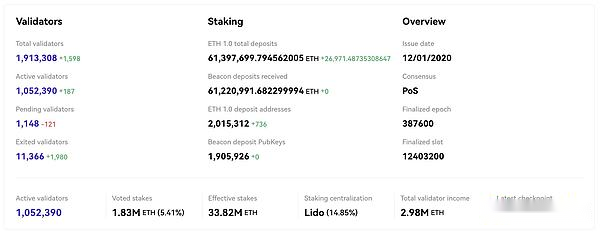
author:imToken; Source: X, @imTokenOfficial; Compilation: Shaw bitchain vision
Ethereum is at a rare moment, with multiple forces gathering.
On-chain ETH staking continues to grow, creating a situation that can be regarded as a “risk-free interest rate” on-chain.In traditional markets, spot ETFs have been in operation for more than a year, and transaction volume and capital inflows have been accelerating, showing increasing institutional interest.Meanwhile, U.S. listed companies are increasingly adding Ethereum to their reserve assets.
Staking, ETFs and corporate reserves are promoting each other, making ETH less a simple token, but a broader financial asset with profits, regulated access and balance sheet utility.
If Bitcoin is “digital gold”, then Ethereum will become the “global ledger” and 2025 will be a critical moment for its integration.
1. Pledge climbing—Ethereum base interest rate formation
The Ethereum Shanghai upgrade in April 2023 eliminated the barriers to exit by enabling withdrawals, unlocking the growth potential of staking.Liquid staking tokens (LST) are expanding rapidly, and the staking rate continues to rise.
Ethereum has pledged more than 33.8 million, about $140 billion at current prices, accounting for more than 25% of the total supply, compared to only about 10% a few years ago.This enhances network security and, from a supply and demand perspective, increases the scarcity of ETH.
 Crucially, pledge is becoming the “interest rate benchmark” on the chain.
Crucially, pledge is becoming the “interest rate benchmark” on the chain.
Annualized yields of 3%-5% have been widely accepted over the past year, and in some institutional studies it is considered an on-chain asset similar to U.S. Treasury bonds, implicitly associated with the Treasury yield curve.ETH has surpassed purely trading assets and laid a foundation similar to fixed income assets.
However, a short-term counter-trend has recently emerged.Starting July 16, exit requests surged: the number of validator exits rose from less than 2,000 to 475,000 on July 22, and the waiting time was extended from less than an hour to more than eight days.
According to The Block, about 670,000 ETH (approximately $3.1 billion) is currently in the exit queue, far exceeding the number of new stakes, and the processing time is close to 12 days.In the context of market rise, the main drivers include the removal of the leveraged pledge cycle, the management of LST decoupling risks, and arbitrage, with Lido, EthFi and Coinbase being the main sources of exits.
 Even so, the long-term trend remains unchanged.In 2024, U.S. Treasury yields remained stable in the 4% to 5%, which made Ethereum’s staking yields relatively unattractive on the basis of risk adjustments.However, as the Fed starts a cycle of interest rate cuts in 2025, Ethereum’s 3% to 5% staking returns have regained its relative appeal, and under certain risk frameworks, it is even classified as a source of “excess gains.”
Even so, the long-term trend remains unchanged.In 2024, U.S. Treasury yields remained stable in the 4% to 5%, which made Ethereum’s staking yields relatively unattractive on the basis of risk adjustments.However, as the Fed starts a cycle of interest rate cuts in 2025, Ethereum’s 3% to 5% staking returns have regained its relative appeal, and under certain risk frameworks, it is even classified as a source of “excess gains.”
This shows that Ethereum’s on-chain returns are increasingly implicitly connected to the global liquidity environment.In particular, re-staking agreements such as EigenLayer have attracted more than $10 billion in ETH, thus forming a logical chain: pledge income → re-staking premium → protocol security.
In other words, Ethereum is no longer just an asset, but is gradually evolving into the basic collateral of the Web3 financial system.
2. ETFs have become the main entry channel for traditional capital
In May 2024, the U.S. Securities and Exchange Commission (SEC) approved the 19b-4 application for eight Ethereum spot ETFs that began trading on July 23, thus building a regulated bridge for Wall Street.Ethereum spot ETF has been on the market for more than a year.
As an entry point for compliance, ETFs provide an easy way for institutions to access ETH while reducing audit and accounting complexity.According to SoSoValue, the U.S. spot ETF has a net asset of more than $27 billion, accounting for about 5.3% of Ethereum’s market value, with a cumulative net inflow of $12.4 billion since its launch.
Markets tend to overestimate short-term novelty and underestimate long-term effects, as do Ethereum ETFs: As of May 2025, their average daily trading volume remained at a low level.

The turning point occurred on August 11, 2025: A single-day net inflow exceeded US$1 billion for the first time.BlackRock’s ETHA attracted $640 million and Fidelity’s FETH attracted $277 million – highlighting the decisive shift to institutional investors.
ETFs not only play an important role as capital channels, but also as transparent and auditable positions, lowering the threshold for institutional investors to adopt ETH.They also open up cross-border allocation and arbitrage channels.Market share is also concentrated: BlackRock and Fidelity currently control about two-thirds of the U.S. Ethereum ETF market, and this top-heavy structure may amplify liquidity and shift the price discovery mechanism to a more institutionalized model.
3. ETH appears on the balance sheet of US companies
If MicroStrategy’s Bitcoin strategy is a milestone for cryptocurrencies in corporate treasury reserves, 2025 is expected to be a turning point for ETH.More and more publicly traded U.S. companies are incorporating ETH into their balance sheets—not a symbolic move, but through large-scale strategic allocations.
BitMine reports that its cryptocurrency holdings exceed $6.6 billion, an increase of about $1.7 billion from $4.9 billion a week ago.These include 1.523 million ETH (about $4326 each) and 192 BTC.
Additionally, Cosmos Health (NASDAQ: COSM) announced a securities purchase agreement with a U.S. institutional investor to launch an ETH reserve strategy, with BitGo Trust, which provides custody and staking infrastructure.
This is a clear difference from ETF investment exposure: ETFs provide portfolio exposure, while Ethereum is directly incorporated into the corporate balance sheet to establish ETH as an operating asset—for diversification, cross-border settlement, and potential employee or R&D incentives—which suggests that its utility exceeds purely price exposure.
Summarize
After a wave of bearish sentiment, the key narratives of Ethereum are strengthening each other:
-
The pledge yield provides an interest rate benchmark similar to that of Treasury bonds.
-
ETFs open up a regulated configuration channel.
-
Corporate balance sheets bring real reserve and payment utility.
Together, these forces are transforming Ethereum from a token to a core financial infrastructure asset.If Bitcoin is digital gold, then Ethereum is increasingly becoming the liquidity core of global ledgers.







